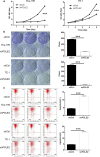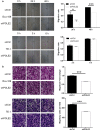POLE2 knockdown reduce tumorigenesis in esophageal squamous cells
- PMID: 32831648
- PMCID: PMC7422519
- DOI: 10.1186/s12935-020-01477-4
POLE2 knockdown reduce tumorigenesis in esophageal squamous cells
Abstract
Background: Esophageal squamous cell carcinoma (ESCC) is one of the most frequent malignant tumors originated from digestive system around the world and the treatment was limited by the unclear mechanism. DNA polymerase epsilon 2, accessory subunit (POLE2) is involved in DNA replication, repair, and cell cycle control, whose association with ESCC is still not clear.
Methods: In this study, the expression level of POLE2 in ESCC tissues was detected by IHC. The POLE2 knockdown cell line was constructed, identified by qPCR and western blot and used for detecting cellular functions and constructing xenotransplantation mice model. MTT Assay, colony formation assay, flow cytometry, wound-healing assay and Transwell assay were used to detected cell proliferation, apoptosis and migration.
Results: We firstly identified that the expression of POLE2 was overexpressed in ESCC. Moreover, the high expression of POLE2 can predict the tumor deterioration and poor prognosis of ESCC patients. Additionally, downregulation of POLE2 was involved in ESCC progression by promoting proliferation, migration, and inhibiting apoptosis in vitro. In vivo studies proved that POLE2 was positively correlated with ESCC tumor formation, which was consistent with the results in vitro. We also illuminated that POLE2 knockdown upregulated pro-apoptotic proteins (Bax, Caspase3, CD40L, FasL, IGFBP-5 and P21) and downregulated anti-apoptotic proteins (CLAP-2, IGF-I and sTNF-R2). In addition, POLE2 was involved in ESCC via targeting PI3K/Akt, Cyclin D1 signaling pathway.
Conclusions: Therefore, POLE2 was proved to be involved in the development of ESCC, which may be a potential therapeutic target and bring new breakthroughs in the treatment of ESCC.
Keywords: Cell apoptosis; Cell migration; Cell proliferation; ESCC; POLE2.
© The Author(s) 2020.
Conflict of interest statement
Competing interestsThe authors declare no conflict of interest.
Figures





References
LinkOut - more resources
Full Text Sources
Research Materials

